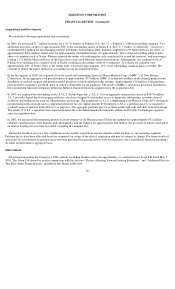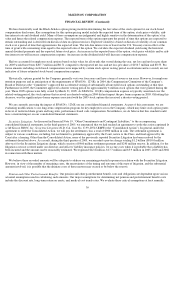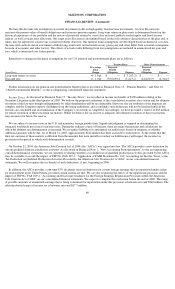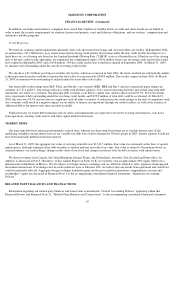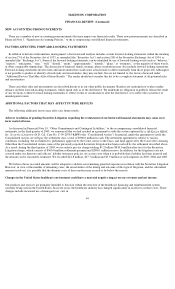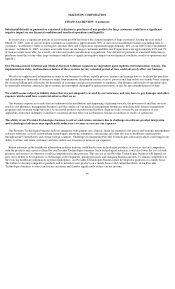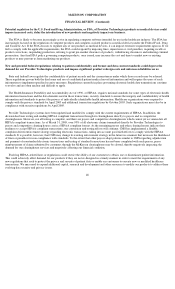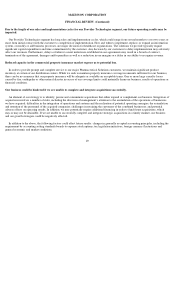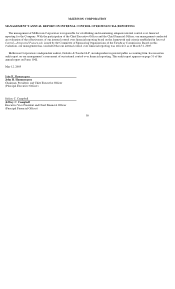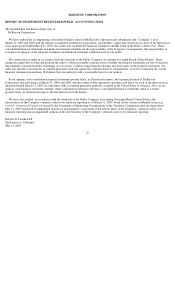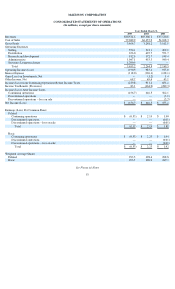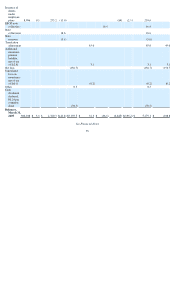McKesson 2005 Annual Report Download - page 46
Download and view the complete annual report
Please find page 46 of the 2005 McKesson annual report below. You can navigate through the pages in the report by either clicking on the pages listed below, or by using the keyword search tool below to find specific information within the annual report.
McKESSON CORPORATION
FINANCIAL REVIEW (Continued)
Substantial defaults in payment or a material reduction in purchases of our products by large customers could have a significant
negative impact on our financial condition and results of operations and liquidity.
In recent years, a significant portion of our revenue growth has been with a limited number of large customers. During the year ended
March 31, 2005, sales to our ten largest customers accounted for approximately 50% of our total consolidated revenues (including sales to
customers’ warehouses). Sales to our largest customer, Rite Aid Corporation, represented approximately 10% of our 2005 total consolidated
revenues. At March 31, 2005, accounts receivable from our ten largest customers and Rite Aid Corporation were approximately 49% and 7%
of total accounts receivable. As a result, our sales and credit concentration is significant. Any defaults in payment or a material reduction in
purchases from this or any other large customer could have a significant negative impact on our financial condition, results of operations and
liquidity.
Our Pharmaceutical Solutions and Medical-Surgical Solutions segments are dependent upon sophisticated information systems. The
implementation delay, malfunction or failure of these systems for any extended period of time could adversely affect our business.
We rely on sophisticated information systems in our business to obtain, rapidly process, analyze and manage data to: facilitate the purchase
and distribution of thousands of inventory items from numerous distribution centers; receive, process and ship orders on a timely basis; manage
the accurate billing and collections for thousands of customers and process payments to suppliers. Our business and results of operations may
be materially adversely affected if these systems are interrupted, damaged by unforeseen events, or fail for any extended period of time.
We could become subject to liability claims that are not adequately covered by our insurance, and may have to pay damages and other
expenses which could have a material adverse effect on us.
Our business exposes us to risks that are inherent in the distribution and dispensing of pharmaceuticals, the provision of ancillary services
(such as our pharmacy management business) and the conduct of our medical management businesses (which include disease management
programs and our nurse triage services.) A successful product or professional liability claim not fully covered by our insurance or any
applicable contractual indemnity could have a material adverse effect on our business, financial condition or results of operations.
The ability of our Provider Technologies business to attract and retain customers due to challenges in software product integration
and technological advances may significantly reduce our revenues or increase our expenses.
Our Provider Technologies business delivers enterprise-wide patient care, clinical, financial, managed care, payor and strategic management
software solutions, as well as networking technologies, electronic commerce, outsourcing and other services to healthcare organizations
throughout the United States and certain foreign countries. Challenges in integrating Provider Technologies software products could impair our
ability to attract and retain customers and may reduce our revenues or increase our expenses.
Future advances in the healthcare information systems industry could lead to new technologies, products or services that are competitive
with the products and services offered by our Provider Technologies business. Such technological advances could also lower the cost of such
products and services or otherwise result in competitive pricing pressure. The success of our Provider Technologies business will depend, in
part, on its ability to be responsive to technological developments, pricing pressures and changing business models. To remain competitive in
the evolving healthcare information systems marketplace, our Provider Technologies business must develop new products on a timely basis.
The failure to develop competitive products and to introduce new products on a timely basis could curtail the ability of our Provider
Technologies business to attract and retain customers and thereby significantly reduce our net income.
46


